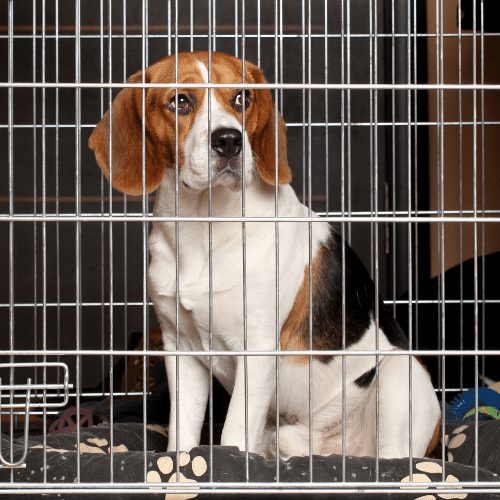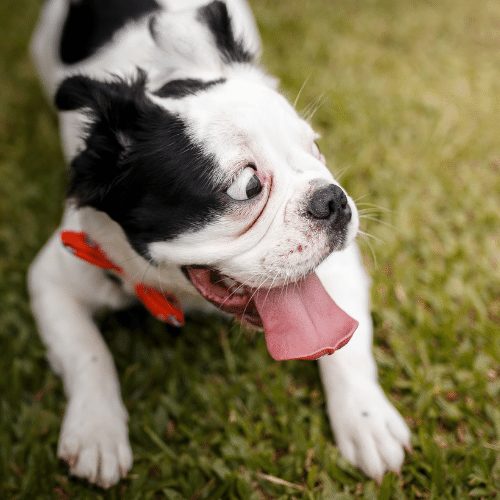Does Crate Training Help Separation Anxiety?
March 18, 2021 2021-11-12 8:18Is your dog struggling with separation anxiety? Living with a dog who cannot be by himself can be extremely taxing on the owner. While looking for solutions, you may have come across the recommendation to crate train your dog. But does crate training really help with separation anxiety?
The quick answer is no. If your dog already has ingrained separation anxiety, crating alone cannot change this. You will need to take a number of other steps to effectively address this behavior. In combination with other approaches though crate training can help a dog work towards decreased separation anxiety.
Table of Contents

Can crate training help with separation anxiety?
In order to answer this question, we need to understand what separation anxiety is and why dogs develop it.
Staying alone
It is not a natural behavior for dogs to stay by themselves for longer periods of times. As social animals, they are best adapted to be in groups. Dogs that live in a household with other dogs usually have a much lower chance of developing separation anxiety from their owner as they are never “truly alone”.
Ideally you should introduce staying alone at home in many small steps. If you have a puppy, leave him for short intervals, every day. Instead of only having occasional and long separations, make them short and frequent.
If this is not trained well during a dog’s first year of life, chances are that the dog can develop separation anxiety.
Separation anxiety is also very common in rescue dogs. They have strong trauma linked to being left alone so of course they do not want their owners to leave.

Signs of separation anxiety
A dog with separation anxiety will essentially have a “doggy panic attack” whenever the owner leaves the house. The dog may whine, pace incessantly, drool, bark etc. Some dogs injure themselves in an attempt to break out of the house.
This actually happens a lot of dogs that are crated while the owner leaves – a sign that a crate alone is not going to change your dog’s behavior. These dogs try to chew on the crate and scratch obsessively. Quite often the owner comes home to a dog whose paws are bloody and whose lips are torn from the crate or the crate water bowl.
If the dog is not crated, he often paces around tirelessly and is unable to settle. This is where a crate – if used appropriately – can help:
Using a crate to restrict motion
When a dog is pacing around tirelessly, then the action of moving itself is making him more and more worked up. Like an animal in a zoo, the incessant walking up and down is not a beneficial behavior and will add to the stress your dog already experiences.
Whenever a dog is moving obsessively like this, it can be useful to restrict their motion so that they do not keep on hyping themselves up through the motion.
Once again:
It is not enough to simply put a dog with separation anxiety in a crate and hope for the best. This will only work in combination with other approaches.
If your dog has never been crated before, you can also use an exercise pen or put your dog into a separate room. If your dog is already scared of a crate, this is not going to help him with being scared of you leaving. Simply using an indestructible crate won’t help – your dog will only get into a higher state of panic!
Steps to using a crate to combat separation anxiety
As mentioned above, this will work best if your dog already has a positive association to the crate itself. If he is scared of the crate, you should use a different method of containment for this.
#1 Get some amazing treats.
The better the treats are, the faster you can change your dog’s response to being alone. You can try hotdogs, cheese, chicken or bologna.
Ideally though you should also pick a “longer-lasting” treat that your dog can chew. Try different chew items such as bully sticks, filled and frozen Kongs or beef trachea.
#2 Have your dog go into the crate and reward him a lot.
Give him his treats and chewies. At first you can simply stand next to the crate as your dog is in there eating and gnawing.
#3 Potter around the room.
As your dog is in the crate enjoying his treats, you can walk around the room. Put away some stuff, fold laundry, talk to family members etc. – your dog should experience that even though you are not standing right next to him, you are not disappearing!
#4 Leave the room for brief periods.
Now try to leave the room for brief periods and return right away. Your dog can look up from his chews as you leave but he should not be in a panic. At first you might only leave for 5-10 seconds, walk up and down the hallway and return. It is really important that your dog does not panic! You want him to experience that even if you leave, you will return.
#5 Gradually extend the time you are leaving.
Over time you should increase how long you leave your dog alone. You will not be able to go from 10 seconds to 3 hours in one week – don’t try it! The more patient you can be, the better your dog will learn.
Your dog should make hundreds of positive experiences in his crate. He should see over and over that every time he goes into his crate, he gets something great to chew on and you leave and return.
#6 Make sure your dog is safe.
Your dog should not be wearing a collar with tags while in his crate. For strong breeds such as Pitbulls you will need strong crates!
Always ensure that your dog is safe and that the crate is secure.
The Bottom Line
A crate alone will not solve separation anxiety issues. You cannot simply put a dog with strong separation anxiety in a crate and hope for the best.
However, if you can combine the crate training process with a lot of positive connections and very gradually extend the period that you leave your dog alone, it can be a helpful tool. Crates (or also exercise pends and small rooms) effectively stop the incessant motion some dogs with separation anxiety exhibit.
Of course, you should always make sure that the crate you are using is safe for your dog and that he cannot hurt himself or get stuck.
